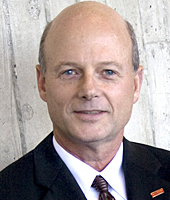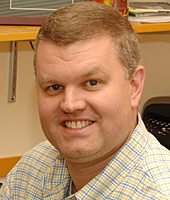AMES, Iowa -- Sixty-eight percent of Iowa's 1,477 public schools met annual federal targets in math and reading -- down from 91 percent of schools in 2006-07 -- according to "The State Report Card for No Child Left Behind" released by the Iowa Department of Education last week.
Department officials attributed the results to tougher No Child Left Behind (NCLB) standards, which will continue to rise over time. And while that may be true, two Iowa State University education faculty members say the report should suggest to educators that there's room for improvement.
David Whaley, who directs ISU's Teacher Education Program as an associate dean for teacher education, agrees that the federal bar for achieving proficiency is being raised. But he says Iowa schools also need to be more receptive to ideas outside of their local control.
"There is a strong sense of local control within Iowa," said Whaley, who also is president of the Iowa Association of Colleges for Teacher Education (http://iowacte.org/). "Local control is absolutely a terrific thing, except when schools and districts are being judged by a common measure -- and that's how well students are doing on the standardized tests."
Whaley reports that Gov. Chet Culver signed a bill back on May 1 which established a more standardized Iowa core curriculum. The State Board of Education had previously approved essential concepts and skills for kindergarten through eighth grade in literacy, math, and science. It also approved the essential concepts and skills for high school students in social studies and 21st century skills.
The State Department of Education is now rolling out the Iowa core curriculum, which must be implemented in high schools by July 1, 2012, and at the K-8 grade levels by 2015. Whaley says the sooner local schools can embrace it, the sooner they'll experience its benefits.
"There's no question that establishing the well-thought-out core curriculum is important, because of its alignment with standardized tests," said Whaley, who was involved on the state committee that helped to draft sections of the core curriculum. "I think that those who have supported local control for a long time may not be as strong of proponents for it."
He says universities like Iowa State can improve statewide education by producing better teachers. The ISU program is implementing tougher state standards for teacher candidates -- requiring them to study in clinical (classroom) settings for a minimum of 80 hours prior to student teaching, and then requiring a minimum of 14 weeks in full-time student teaching. Whaley reports that teacher education candidates are monitored closely throughout the program -- both in and out of classroom settings.
Local school districts also need to monitor student progress more often, says Scott McLeod, an ISU associate professor of educational leadership and policy studies. McLeod is serving on a seven-member team that will develop a federal "What Works Clearinghouse Data-Driven Decision-Making Practice Guide" -- a joint project of the United States Department of Education Institute of Education Sciences, the RAND Corporation, and Mathematica Policy Research.
McLeod says past research is pretty clear that the following steps can improve student achievement in schools:
- Monitor student progress during the school year. "Rather than waiting until the end and the big test, you check in during the year, which gives you opportunity to adjust your instruction based on those results," McLeod said. "It's an issue of benchmarking or dip-sticking along the way so you can change what's happening in the classroom for the benefit of the kids."
- Give teachers the time, space and training to look at the data from those assessments. "It does no good to just do the assessments if you don't have a chance to come together to make meaning of it," he said. "Schools are calling those sessions PLCs or Professional Learning Communities. And getting those up and running can be a real challenge because schools either don't have time in the schedule, or they don't know how to do that right."
- Make the instructional changes. "You've gathered the data and you come together to make sense of it. Now you come in as a team to go out and make those changes for some period of time, like a month or six weeks," he said. "Then you come back with new data in hand and say, 'Did what we tried work?' And if it did, 'How do we build off of it?' And if it didn't, 'What do we need to tweak or fix?'
"If you do that on a regular basis during the school year, kids' achievement goes up, because you're adjusting to their needs while you have them in the classroom," McLeod said.
And it's not all bad news when it comes to Iowa's education assessment. Whaley noted that Iowa students scored the second highest in the nation collectively on the ACT college entrance exam.
"There are a number of other statistics available that show Iowa's students are achieving remarkable success in their learning," he said. "Therefore, even the most recent report on the decline in Adequate Yearly Progress needs to be interpreted in light of this being just one measure of many of student achievement."

